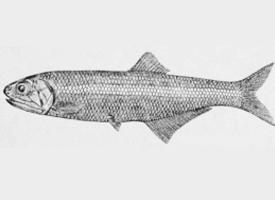
Poids et mesures
| Longueur | de 10 à 15 cm |
|---|
Description de l'animal
The European anchovy (Engraulis encrasicolus) is a small, yet ecologically and commercially significant fish that inhabits the temperate waters of the northeastern Atlantic Ocean, including the Mediterranean Sea and the Black Sea. This species is an integral part of marine ecosystems and a key species in the fishing industry, known for its distinct flavor and nutritional value.Morphologically, the European anchovy is a slender and elongated fish, typically measuring between 12 to 15 centimeters in length, although it can reach up to 20 centimeters in some cases. It possesses a silvery underbelly that gradually transitions to a green or blue shade on its back, creating a natural camouflage in the water column. This coloration not only helps in evading predators but also aids in their predatory behavior. The fish is characterized by its large mouth, which extends behind the eyes, and a sharp snout. Its body is covered in small, smooth scales, and it has a single dorsal fin located midway along its body, with a series of small finlets following the anal fin towards the tail.
European anchovies are pelagic fish, meaning they inhabit the open water column, rather than the ocean floor. They are highly mobile and form large schools, which can be found from the surface down to depths of about 400 meters, although they predominantly stay within the upper 200 meters of the water column. These schools are not only a defense mechanism against predators but also enhance their efficiency in feeding.
The diet of the European anchovy primarily consists of planktonic organisms, including both phytoplankton and zooplankton. Their feeding behavior is facilitated by their gill raker structure, which allows them to filter feed as they swim with their mouths open, ingesting large quantities of plankton. This diet is rich in nutrients, which contributes to their rapid growth and reproductive cycles.
Reproduction in European anchovies is highly dependent on the temperature of their surrounding environment, with spawning occurring when water temperatures reach between 12 to 20 degrees Celsius. They exhibit a high fecundity rate, with females capable of producing tens of thousands of eggs each spawning season. The eggs are pelagic, drifting with the currents until hatching, which occurs within a few days, depending on the water temperature.
European anchovies play a crucial role in their ecosystems, acting as a bridge in the food web. They consume primary producers (plankton) and in turn are preyed upon by a wide range of higher trophic level predators, including larger fish, seabirds, and marine mammals. Their schooling behavior makes them an attractive target for commercial fisheries, which harvest them for food, bait, and the production of fishmeal and fish oil.
The fishing of European anchovies is a significant economic activity in many countries bordering the Mediterranean Sea and the eastern Atlantic Ocean. They are harvested using various methods, including purse seines and pelagic trawls. Despite their abundance, the European anchovy populations are subject to fluctuations due to environmental conditions, particularly temperature and food availability, which can affect their recruitment and, consequently, the sustainability of the fishery.
In culinary terms, European anchovies are highly prized for their rich, umami flavor. They are consumed fresh, canned, or processed into products like anchovy paste and anchovy fillets preserved in oil or salt. These products are staples in many Mediterranean cuisines, contributing to the unique flavors of dishes across the region.
In summary, the European anchovy (Engraulis encrasicolus) is a small, pelagic fish that plays a significant ecological and economic role in its native habitats. Its life cycle, behavior, and interactions within the marine ecosystem highlight its importance in the biodiversity of the oceans, while its culinary value underscores its significance to human culture and economies around the Mediterranean and beyond.
Nouvelles photos d'animaux
Top 10 des animaux
- Dolphin gull (Leucophaeus scoresbii)
- Diana monkey (Cercopithecus diana)
- Moustached guenon (Cercopithecus cephus)
- Galápagos tortoise (Geochelone nigra complex)
- Russian tortoise (Testudo horsfieldii)
- Stone loach (Barbatula barbatula)
- Japanese macaque (Macaca fuscata)
- Greek tortoise (Testudo graeca)
- Common flying dragon (Draco volans)
- Vendace (Coregonus albula)